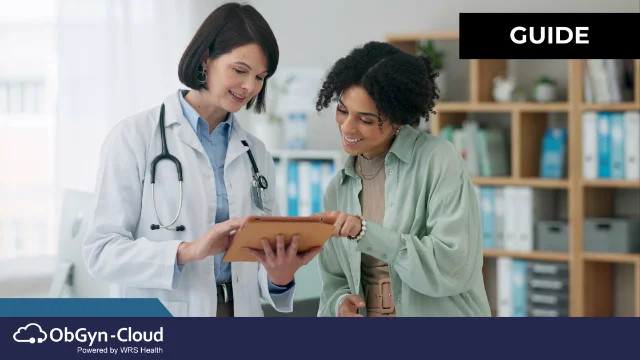Key Takeaways
- OBGYN AI tools reduce documentation time and help prevent provider burnout.
- Intelligent chart summarization simplifies complex patient histories.
- Built-in billing alerts reduce coding errors and protect revenue.
- Schedule a 1:1 with our team to learn about our AI features.
Feeling stuck behind your EHR?
You’re not alone. EHR systems were meant to simplify care, but many OB/GYN providers find they’re spending more time on documentation than with their patients.
That’s starting to change. Thanks to the rise of AI in OBGYN, new tools are emerging that actually lighten your workload—without disrupting your workflow.
Here are five headaches that AI in EHRs can help relieve—starting now.
Table of Contents
1. Documentation That Consumes Your Time
A 20-minute visit can lead to 10 minutes of charting. Multiply that by a full day, and it’s no surprise OB/GYNs are finishing notes long after their last patient leaves.
That burden adds up—emotionally and clinically. Providers without enough documentation time are nearly 3x more likely to experience burnout.
AI EHR Solutions for OBGYN Note Fatigue
Modern OBGYN AI features—like ambient listening, virtual scribes, and real-time transcription—capture the encounter as it happens and convert it into structured notes. No more typing from memory. Just review, sign, and move on.
Less late-night charting. More accurate notes. More time for patients and yourself.
2. Overwhelming Patient Data
Between prenatal visits, fertility consults, lab work, imaging, and patient messages, OB/GYN records are packed with information. Add in external reports or wearables, and it’s easy to miss critical insights before an appointment.
This has real implications: 45% of malpractice claims stem from misdiagnoses, and 10% involve medication errors—often fueled by fragmented data systems.
AI in OBGYN That Surfaces What Matters
AI-driven summarization highlights relevant updates like abnormal labs, flagged vitals, or recent ED visits—right when you need them. Instead of digging through tabs, you see a clear, prioritized view of what matters most.
AI in OBGYN helps you walk into every visit prepared—not buried in paperwork.
3. Coding Errors That Can Cost You
Even experienced billing teams make errors—and the stakes are high. One report shows that 32% of claim rejections are due to coding or documentation issues.
Missed codes, overcoding, or undercoding all impact revenue—and slow down reimbursement.
AI EHR Systems That Guard Your Bottom Line
OBGYN AI tools can suggest charges based on visit notes, catch documentation gaps, and provide alerts when something’s missing. That means fewer delays, fewer denials, and a smoother revenue cycle overall.
You focus on care. Let your AI EHR watch your billing blind spots.

4. Time-Wasting Chart Searches
Looking for a past pap result or surgical note can take several minutes too many—especially in charts with years of detailed OB/GYN history.
And with 129 million Americans managing at least one chronic condition, patient records will only get longer.
AI EHR Solutions That Act Like a Second Brain
Large language model (LLM) search tools now built into AI EHR solutions let you type a question—“When was the last cervical cytology?”—and get an answer instantly.
It’s like having a hyper-organized assistant who never forgets where anything is filed.
5. Revenue Leaks From Missed Charges
In a busy OB/GYN clinic, it’s easy to forget a charge here or there—especially with back-to-back patients. But those small misses can add up to a major revenue leak over time.
Let OBGYN AI Catch What You Might Miss
AI tools scan your clinical documentation and visit types to identify likely missed charges. Some can even suggest the right code in real time—without disrupting your flow.
That means better reimbursement, more accurate billing, and fewer financial headaches at month-end.
Reimagine Your Practice With AI in OBGYN EHRs
OBGYN AI isn’t a futuristic concept—it’s here, embedded in the EHRs many practices already use. These features don’t replace providers. They help them.
AI in OBGYN helps you cut down on busywork, see what matters faster, and spend more time practicing medicine—not clicking boxes.










